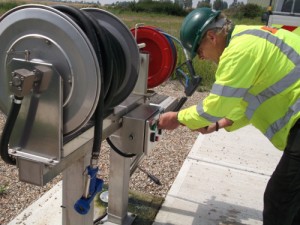The scope of the project was to improve the existing Wash down system at Hosea’s Headway at the MOD and build a new wash down facility at X5 facility. It was part of the Sands Fleet Life Extension of Project 767. Extensive wash down of defence vehicles is required to maintain vehicle hygiene and prevent wear and tear.
 The project was a Turn Key Project to design, construct and maintain the vehicle wash-down facility. Various environmental issues were encountered as the site was classified as SSSI site. There were various issues with planning permission and achieving environmental consent for discharging the trade effluent. However, by designing a sustainable solution that met stringent discharge quality standards, Owls Hall successfully achieved the consent of the Environmental Agency.
The project was a Turn Key Project to design, construct and maintain the vehicle wash-down facility. Various environmental issues were encountered as the site was classified as SSSI site. There were various issues with planning permission and achieving environmental consent for discharging the trade effluent. However, by designing a sustainable solution that met stringent discharge quality standards, Owls Hall successfully achieved the consent of the Environmental Agency.
Further, the construction works included building self-service vehicle wash down bays at both the facilities. Each vehicle wash-down facility included a wash-down station with hose reels and controls, one supplying recycled high pressure wash and the other supplying low pressure clean water. The design layout also included a jet wash machine, wash bay silt trap, wash-down separator and a water reclaim system. On the X5 Facility, the project employed sustainable drainage techniques by installing a reed bed to treat the over-flow water from the wash down system. This was an important requirement to achieve the l Environmental Agency’s consent to discharge license.
Further, the project made provision for the positive drainage and control of surface water within the site via an oil interceptor. The three stage interceptor was installed to prevent drain blockages and pollution discharge to the foul drain. The project allowed use of sustainable surface drainage techniques by introducing a living soakaway that filtered such contaminants as heavy metals, salt, grease, etc. from the overflow wash down water.
In addition, installing a total water reclaim system in the wash-down facility helped reduce mains water costs, alleviate drainage issues, allow washing during water scarcity conditions and reduce the impact on the environment. The system also complied with the Environmental Agency requirements and Pollution Prevention Guideline (PPG13 – 3.1) thus helping to resolve planning permission issues.
The typical challenge in delivering this project was to demonstrate application of project management methodology and good governance for the duration of the project. These challenges were successfully overcome by agreeing expectations and maintaining clear communication at all the times. In addition, the implementation of risk reviews, project audits and having recovery plans ensured complete success.





